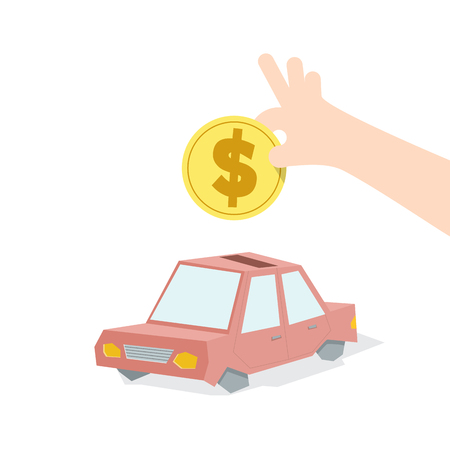1. What are Collision and Comprehensive Coverage?
When shopping for auto insurance in the U.S., you’ll often hear about collision and comprehensive coverage. These two types of coverage are important options that can protect your vehicle, but they serve different purposes from liability insurance. Here’s what you need to know.
Understanding Collision Coverage
Collision coverage helps pay for repairs to your car if it’s damaged in an accident, regardless of who was at fault. This includes collisions with other vehicles or even objects like trees, guardrails, or fences. If you’re financing or leasing your car, lenders usually require collision coverage.
Examples of Collision Coverage
- You hit another car at an intersection.
- Your vehicle slides on ice and crashes into a pole.
- You accidentally back into a mailbox.
Understanding Comprehensive Coverage
Comprehensive coverage protects your car from damage not caused by a collision. This means things like theft, vandalism, natural disasters (like hail or floods), fire, or hitting an animal (like a deer). It’s also commonly required by lenders if you’re still paying off your car.
Examples of Comprehensive Coverage
- Your car is stolen from a parking lot.
- A tree branch falls on your parked car during a storm.
- Your windshield is broken by flying debris.
How Do They Differ from Liability Coverage?
The main difference between these coverages and liability coverage is what—and who—they protect. Liability insurance covers damages you cause to other people’s property or injuries to others in an accident where you are at fault. Collision and comprehensive, on the other hand, help pay for repairs to your own vehicle.
Coverage Comparison Table
| Coverage Type | What It Covers | Who/What Is Protected | Required by Law? |
|---|---|---|---|
| Liability | Other people’s property and injuries | Others involved in an accident you cause | Yes (in most states) |
| Collision | Your vehicle in a crash or collision | Your own vehicle | No (but often required by lenders) |
| Comprehensive | Theft, vandalism, natural disasters, non-collision events | Your own vehicle | No (but often required by lenders) |
Key Takeaway:
If you want protection for your own car beyond just covering damage you might cause to others, both collision and comprehensive coverage can be essential parts of your auto insurance policy—especially if you live in areas prone to severe weather or high rates of theft.
2. How Do Collision and Comprehensive Coverage Work?
When it comes to auto insurance, understanding the difference between collision and comprehensive coverage can help you make smart decisions about your protection. These two types of coverage handle different situations you might face on American roads or even in your own driveway. Let’s break down what each covers, using real-life examples you might see across the United States.
What Does Collision Coverage Include?
Collision coverage pays for damage to your vehicle when youre involved in an accident, no matter who is at fault. This could be a fender bender on a busy Los Angeles freeway, backing into a pole at a Walmart parking lot in Texas, or hitting black ice and sliding into a guardrail in Michigan. Basically, if your car collides with another car or object, collision coverage steps in.
Common Examples Covered by Collision:
- You rear-end another car at a stoplight in New Jersey
- Your teen accidentally hits the garage door while pulling out in Ohio
- You swerve to avoid a deer in Colorado and hit a tree
What Does Comprehensive Coverage Include?
Comprehensive coverage protects against damage to your car that doesn’t result from a collision. Think of it as protection against the unexpected: theft, vandalism, natural disasters, fire, and more. For example, if your car is stolen from outside your apartment in Chicago, or hail cracks your windshield during a Kansas thunderstorm, comprehensive coverage helps cover the repairs or replacement.
Common Examples Covered by Comprehensive:
- Your car is stolen while parked on a San Francisco street
- A tornado causes a tree branch to fall on your vehicle in Oklahoma
- Your car is keyed by vandals at a stadium in Florida
- A wildfire damages your SUV in California
- A hailstorm dents your roof and hood in Nebraska
Quick Comparison Table: Collision vs. Comprehensive Coverage
| Type of Coverage | What It Covers | Example Scenario |
|---|---|---|
| Collision | Accidents involving another vehicle or object (regardless of fault) | You hit another car at an intersection in Atlanta |
| Comprehensive | Theft, vandalism, natural disasters, fire, falling objects, animal collisions (excluding hitting another car) | A hailstorm damages your car in Denver or someone steals your SUV in Seattle |
Important Note:
Neither collision nor comprehensive covers normal wear and tear or mechanical breakdowns. These policies focus on sudden, unexpected events rather than routine maintenance issues.

3. Who Needs Collision and Comprehensive Coverage?
Understanding When These Coverages Make Sense
Not every driver needs both collision and comprehensive coverage, but for many Americans, these protections offer valuable peace of mind. Whether you should add them to your auto insurance policy depends on a few key factors: the age and value of your car, if you have a loan or lease, and your personal financial situation.
Vehicle Age and Value
If your car is new or holds significant value, collision and comprehensive coverage can help protect your investment. On the other hand, if you drive an older vehicle with a low market value, the cost of these coverages might outweigh any potential benefit in case of a claim.
Coverage Recommendation by Vehicle Age and Value
| Vehicle Type | Recommended Coverage | Why? |
|---|---|---|
| New/High-Value Car | Collision & Comprehensive | Protects against expensive repairs or replacement costs. |
| Financed or Leased Car | Usually Required | Lenders typically require full coverage to protect their investment. |
| Older/Low-Value Car | Optional (Consider Dropping) | Payout may be less than the cost of coverage. |
Lease or Loan Requirements
If you’re leasing or financing your vehicle, your lender will almost always require you to carry both collision and comprehensive coverage until you pay off your loan or finish your lease. This is because the lender wants to make sure their asset is protected in case of an accident or unexpected damage.
Your Personal Financial Situation
If paying out-of-pocket for repairs or replacing your car would be a financial hardship, having collision and comprehensive coverage can be a smart choice. Consider how much savings you have available for emergencies—if it’s limited, extra coverage could prevent big bills down the road.
Quick Self-Assessment Guide
| Your Situation | Should You Get Coverage? |
|---|---|
| No emergency savings; cant afford major repairs/replacement | Yes, consider both coverages. |
| Able to pay out-of-pocket if needed; older car with low value | You may skip these coverages. |
| Leasing or financing your car | You will likely be required to carry both. |
| Want extra peace of mind regardless of car value | Certainly consider both coverages. |
Tip for American Drivers:
If youre unsure about whether you need these coverages, talk with an insurance agent who can help assess your unique situation and provide advice tailored to local requirements in your state.
4. Cost Factors and Deductibles
How Premiums Are Determined for Collision and Comprehensive Coverage
When it comes to auto insurance in the U.S., your monthly or yearly premium for collision and comprehensive coverage is based on several factors. Insurance companies look at both you and your car to decide how much you’ll pay. Here are some of the main things they consider:
| Factor | How It Affects Your Premium |
|---|---|
| Car Make and Model | Expensive or high-performance cars often cost more to insure. |
| Your Driving Record | A clean record can lower your costs; accidents or tickets usually raise them. |
| Your Location | Cities with higher theft or accident rates may lead to higher premiums. |
| Your Age and Gender | Younger drivers, especially males under 25, typically pay more. |
| Mileage Driven | The more you drive, the higher the risk, so costs may go up. |
| Credit Score (in most states) | A good credit score can help lower your premium. |
Understanding Deductibles
A deductible is what you agree to pay out of pocket before your insurance kicks in after a covered claim. For example, if you have a $500 deductible and $2,000 in damage, you pay $500 and your insurer pays $1,500. Both collision and comprehensive coverages have separate deductibles, which you choose when you buy your policy.
Choosing the Right Deductible Amount
The deductible amount affects your premium:
| Deductible Amount | Impact on Premiums |
|---|---|
| Lower Deductible ($250–$500) | Higher monthly or annual premiums but less out-of-pocket expense after an accident. |
| Higher Deductible ($1,000+) | Lower premiums but more to pay if you file a claim. |
Tips for Making Cost-Effective Decisions
- Assess Your Car’s Value: If your car is older or has low market value, you might skip collision or comprehensive coverage to save money.
- Choose a Deductible You Can Afford: Don’t pick a deductible so high that paying it would be a financial burden after an accident.
- Bundle Policies: Many insurers offer discounts if you combine auto with home or renters insurance.
- Ask About Discounts: Good driver discounts, anti-theft devices, or even taking a defensive driving course can lower your premium.
- Shop Around: Rates can vary between companies—compare quotes from multiple insurers before deciding.
- Review Annually: Your needs may change over time; check your coverage once a year to make sure it still fits your situation.
Understanding how cost factors and deductibles work helps you make smarter choices about your auto insurance, so you get the protection you need without overpaying.
5. Filing a Claim and What to Expect
Step-by-Step Guide to Filing an Auto Insurance Claim
When youre involved in an accident or your vehicle is damaged, knowing how to file a claim with your auto insurance company can make the process smoother. Here’s a simple, step-by-step guide on what you should do if you need to file a claim under your collision or comprehensive coverage in the United States.
Step 1: Make Sure Everyone Is Safe
Your safety comes first. If anyone is injured, call 911 immediately. Move vehicles out of traffic if possible and make sure everyone is okay.
Step 2: Document the Scene
Take clear photos of all vehicles involved, any property damage, and the accident scene. Gather details such as:
- Date, time, and location of the incident
- Names and contact info for other drivers, passengers, and witnesses
- Insurance details of other parties involved
- A brief description of what happened
Step 3: Notify Your Insurance Company Promptly
Contact your insurance provider as soon as possible. Most companies have a 24/7 claims hotline or mobile app. Provide them with all the information and documentation you gathered.
Common Ways to File a Claim
| Method | Description |
|---|---|
| Phone Call | Call your insurer’s claims department directly. |
| Online Portal | Log in to your insurance company’s website to start a claim. |
| Mobile App | Use the insurer’s app for quick photo uploads and updates. |
| Agent Visit | Your local agent can help guide you through the process. |
Step 4: Work With Your Claims Adjuster
An adjuster will be assigned to review your claim. They may inspect your vehicle in person or request additional photos. Be honest and provide any extra details they need to process your claim efficiently.
Step 5: Get Repair Estimates
Your insurer may recommend certain repair shops, but you usually have the right to choose where your car is fixed. Submit estimates as requested by your adjuster. Depending on your policy, payment might go directly to the shop or be reimbursed to you.
Step 6: Pay Your Deductible
You’re responsible for paying your policy deductible before insurance covers the rest of the costs. This amount varies based on what you chose when setting up your coverage.
Step 7: Track Your Claim Status
You can check updates via phone, online portal, or mobile app. If there are any delays or questions, don’t hesitate to reach out to your adjuster or agent for help.
What Policyholders Should Know About Filing Claims
- Your premium may increase after certain types of claims (especially at-fault accidents).
- Your collision coverage applies if you hit another vehicle or object; comprehensive covers non-collision events like theft or weather damage.
- You must report accidents promptly—delays can affect coverage eligibility.
- If another driver is at fault, their liability insurance may cover some costs (subrogation process).
- If you’re unsure about whether an event is covered, ask your agent before filing a claim.
This straightforward approach helps ensure you get back on the road quickly while making full use of your collision and comprehensive coverage benefits.


